Insights into Duffy binding-like domains through the crystal structure and function of the merozoite surface protein MSPDBL2 from Plasmodium falciparum
- PMID: 22843685
- PMCID: PMC3463323
- DOI: 10.1074/jbc.M112.350504
Insights into Duffy binding-like domains through the crystal structure and function of the merozoite surface protein MSPDBL2 from Plasmodium falciparum
Abstract
Invasion of human red blood cells by Plasmodium falciparum involves interaction of the merozoite form through proteins on the surface coat. The erythrocyte binding-like protein family functions after initial merozoite interaction by binding via the Duffy binding-like (DBL) domain to receptors on the host red blood cell. The merozoite surface proteins DBL1 and -2 (PfMSPDBL1 and PfMSPDBL2) (PF10_0348 and PF10_0355) are extrinsically associated with the merozoite, and both have a DBL domain in each protein. We expressed and refolded recombinant DBL domains for PfMSPDBL1 and -2 and show they are functional. The red cell binding characteristics of these domains were shown to be similar to full-length forms of these proteins isolated from parasite cultures. Futhermore, metal cofactors were found to enhance the binding of both the DBL domains and the parasite-derived full-length proteins to erythrocytes, which has implications for receptor binding of other DBL-containing proteins in Plasmodium spp. We solved the structure of the erythrocyte-binding DBL domain of PfMSPDBL2 to 2.09 Å resolution and modeled that of PfMSPDBL1, revealing a canonical DBL fold consisting of a boomerang shaped α-helical core formed from three subdomains. PfMSPDBL2 is highly polymorphic, and mapping of these mutations shows they are on the surface, predominantly in the first two domains. For both PfMSPDBL proteins, polymorphic variation spares the cleft separating domains 1 and 2 from domain 3, and the groove between the two major helices of domain 3 extends beyond the cleft, indicating these regions are functionally important and are likely to be associated with the binding of a receptor on the red blood cell.
Figures



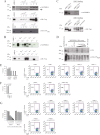
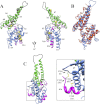


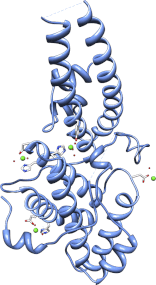
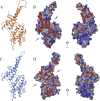
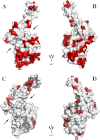
Similar articles
-
Disguising itself--insights into Plasmodium falciparum binding and immune evasion from the DBL crystal structure.Mol Biochem Parasitol. 2006 Jul;148(1):1-9. doi: 10.1016/j.molbiopara.2006.03.004. Epub 2006 Apr 4. Mol Biochem Parasitol. 2006. PMID: 16621067 Review.
-
Structural basis for Duffy recognition by the malaria parasite Duffy-binding-like domain.Nature. 2006 Feb 9;439(7077):741-4. doi: 10.1038/nature04443. Epub 2005 Dec 21. Nature. 2006. PMID: 16372020
-
Mapping a common interaction site used by Plasmodium falciparum Duffy binding-like domains to bind diverse host receptors.Mol Microbiol. 2008 Jan;67(1):78-87. doi: 10.1111/j.1365-2958.2007.06019.x. Epub 2007 Nov 28. Mol Microbiol. 2008. PMID: 18047571
-
Crystal and solution structures of Plasmodium falciparum erythrocyte-binding antigen 140 reveal determinants of receptor specificity during erythrocyte invasion.J Biol Chem. 2012 Oct 26;287(44):36830-6. doi: 10.1074/jbc.M112.409276. Epub 2012 Sep 18. J Biol Chem. 2012. PMID: 22989878 Free PMC article.
-
Conserved residues in the Plasmodium vivax Duffy-binding protein ligand domain are critical for erythrocyte receptor recognition.Proc Natl Acad Sci U S A. 2004 Nov 2;101(44):15754-9. doi: 10.1073/pnas.0405421101. Epub 2004 Oct 21. Proc Natl Acad Sci U S A. 2004. PMID: 15498870 Free PMC article.
Cited by
-
Identification of the minimal binding region of a Plasmodium falciparum IgM binding PfEMP1 domain.Mol Biochem Parasitol. 2015 May;201(1):76-82. doi: 10.1016/j.molbiopara.2015.06.001. Epub 2015 Jun 18. Mol Biochem Parasitol. 2015. PMID: 26094597 Free PMC article.
-
Variable Surface Antigens of Plasmodium falciparum: Protein Families with Divergent Roles.Protein Pept Lett. 2024;31(6):409-423. doi: 10.2174/0109298665298567240530170924. Protein Pept Lett. 2024. PMID: 38910420 Review.
-
Structure of the merozoite surface protein 1 from Plasmodium falciparum.Sci Adv. 2021 Jun 2;7(23):eabg0465. doi: 10.1126/sciadv.abg0465. Print 2021 Jun. Sci Adv. 2021. PMID: 34078606 Free PMC article.
-
Plasmodium falciparum has evolved multiple mechanisms to hijack human immunoglobulin M.Nat Commun. 2023 May 8;14(1):2650. doi: 10.1038/s41467-023-38320-z. Nat Commun. 2023. PMID: 37156765 Free PMC article.
-
The cellular and molecular basis for malaria parasite invasion of the human red blood cell.J Cell Biol. 2012 Sep 17;198(6):961-71. doi: 10.1083/jcb.201206112. J Cell Biol. 2012. PMID: 22986493 Free PMC article. Review.
References
-
- Cowman A. F., Crabb B. S. (2006) Invasion of red blood cells by malaria parasites. Cell 124, 755–766 - PubMed
-
- Singh S. K., Hora R., Belrhali H., Chitnis C. E., Sharma A. (2006) Structural basis for Duffy recognition by the malaria parasite Duffy-binding-like domain. Nature 439, 741–744 - PubMed
-
- Gardner M. J., Hall N., Fung E., White O., Berriman M., Hyman R. W., Carlton J. M., Pain A., Nelson K. E., Bowman S., Paulsen I. T., James K., Eisen J. A., Rutherford K., Salzberg S. L., Craig A., Kyes S., Chan M. S., Nene V., Shallom S. J., Suh B., Peterson J., Angiuoli S., Pertea M., Allen J., Selengut J., Haft D., Mather M. W., Vaidya A. B., Martin D. M., Fairlamb A. H., Fraunholz M. J., Roos D. S., Ralph S. A., McFadden G. I., Cummings L. M., Subramanian G. M., Mungall C., Venter J. C., Carucci D. J., Hoffman S. L., Newbold C., Davis R. W., Fraser C. M., Barrell B. (2002) Genome sequence of the human malaria parasite Plasmodium falciparum. Nature 419, 498–511 - PMC - PubMed
-
- Howell D. P., Levin E. A., Springer A. L., Kraemer S. M., Phippard D. J., Schief W. R., Smith J. D. (2008) Mapping a common interaction site used by Plasmodium falciparum Duffy binding-like domains to bind diverse host receptors. Mol. Microbiol. 67, 78–87 - PubMed
Publication types
MeSH terms
Substances
Associated data
- Actions
- Actions
LinkOut - more resources
Full Text Sources
Molecular Biology Databases
Miscellaneous

